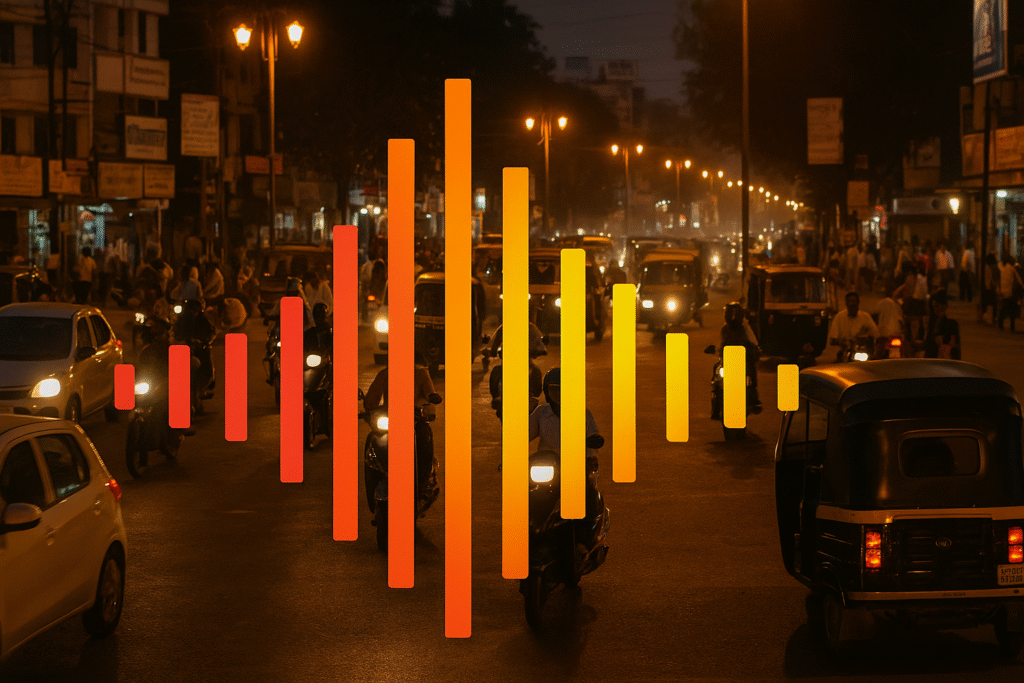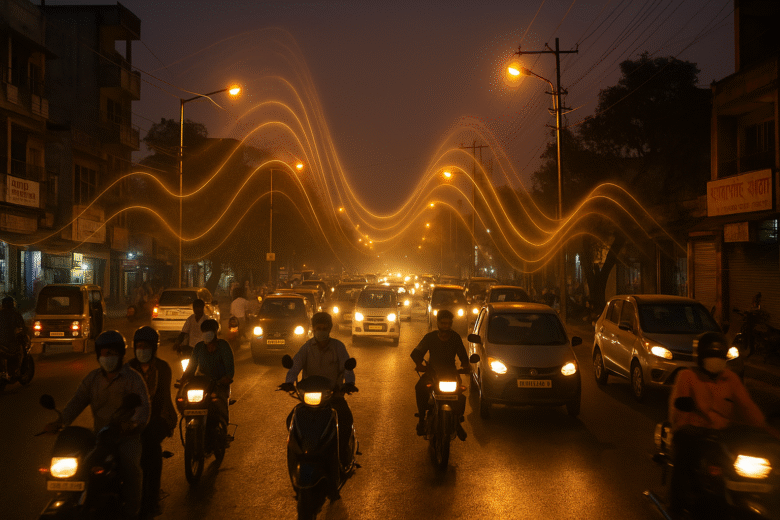Did you know that sound itself can be a silent killer? That’s right—Nagpur Gets Real-Time Noise Monitoring: The Hidden Pollution You Never Saw is not just a headline now, but a reality unfolding in the city. As Nagpur begins to track noise 24/7 alongside air quality, it’s signalling a subtle but profound shift in how we think about the health of our city—and our ears.
Cities in India have long measured air quality in real time, but noise has remained in the shadows—recorded manually during festivals or peak complaints, and mostly ignored otherwise. That’s changing. In a bold move, Nagpur has now installed real-time noise monitors co-located with its air quality stations, pulling back the curtain on a pollution we usually can’t see but always hear. The question now: are we ready to listen?
Why Noise Pollution Matters (More Than You Think)
When we talk about pollution, most of us instantly visualize smog, dusty haze, and toxic gases. But consider this: noise is a pollutant too — invisible, pervasive, and damaging in its own way. Extended exposure to high decibels (sound levels) can lead to stress, sleep disruption, high blood pressure, cardiovascular strain, cognitive impairment in children, and even mental health issues. People living near busy roads, construction zones, or event venues often pay this hidden cost.
In India, the Central Pollution Control Board (CPCB) initiated a Real Time National Ambient Noise Monitoring Network (NANMN) to capture city noise around the clock, starting with pilot installations in major metros. Many monitoring stations were found to exceed safe noise norms, especially in residential and commercial zones. (See Reference below.)
Nagpur itself has had spot studies. For instance, researchers mounted sound meters on bicycles and traversed over 700 locations across the city to develop noise maps. Their findings were not soothing: noise levels frequently breached permissible limits at intersections, commercial zones, and residential clusters. (See Reference below.)
So, when Nagpur’s municipal and pollution control bodies decided to place Continuous Noise Monitoring Stations (CNMS) at existing air quality sites, it wasn’t just a symbolic gesture—it was overdue.
Nagpur’s Real-Time Noise Monitoring: What’s New
Earlier this year, the Maharashtra Pollution Control Board (MPCB) installed four real-time noise monitoring units in Nagpur. These are sited at:
- Town Hall (Mahal area)
- VNIT (near the IT Park)
- LIT (Amravati Road)
- The MPCB office in Civil Lines
These units will run 24/7, measuring noise in real time, and soon the data will be made publicly visible. (Media reports confirm this rollout.)
Why co-locate with air quality stations? Simple: many of the same urban processes (traffic, construction, industry) drive both air and noise pollution. Having side-by-side data allows us to compare spikes and patterns—when smoggy streets also scream with honks.
Now, instead of guessing which neighbourhood is noisy, we’ll know. Instead of relying on citizens’ complaints alone, authorities will see the numbers. It’s a transformation from reactive to proactive.

What This Means for Residents
Transparency & Accountability
When noise levels are out in the open (on dashboards, apps, or public screens), the pressure is on everyone—from traffic police to contractors. If a construction site consistently causes decibels beyond norms, the city has proof to act.
Smarter Zoning, Smarter Planning
Urban planners can use spatial noise maps to designate “quiet zones,” buffer areas, and better align residential areas away from chronic noise sources.
Health Interventions
Correlating noise with hospital visits, sleep disturbance surveys, or stress indicators becomes easier. Public health agencies can pinpoint hotspots needing intervention.
Behavioural Nudges
When people see that their daily route through a busy road drowns their neighbourhood in sound, they may choose alternate paths, avoid honking, or push for quieter commuting choices.
Conflict Resolution
Ever had a neighbour crank up a bass-heavy speaker and argue, “It’s subjective—vacation listening”? With decibel logs, disputes can lean less on emotions and more on data.
Festival Governance
In India, noisy festivals and processions are an annual flashpoint. With real-time monitoring, authorities can impose stricter limits on volume and duration, rather than after-the-fact crackdowns.
Still, a caveat: mere measurement isn’t enough. Enforcement, political will, civic awareness, and infrastructure back-up are essential to make the data matter.
Challenges & Caveats
Enforcement Lag
It’s one thing to measure: it’s another to act. Some legal provisions restrict the MPCB from acting in residential areas without police complaints. The old bureaucratic loops could slow real-time enforcement. (See media reporting.)
Spatial Gaps
Four monitors can only cover so much ground. Many neighborhoods, alleys, and interior localities may stay unmonitored unless monitoring is scaled out.
Calibration & Accuracy
Sensors must be meticulously calibrated to avoid false alarms. Environmental variables (wind, reflections, temperature) must be accounted for.
Public Awareness
Noise data is meaningful only if residents understand and demand accountability. Awareness campaigns must accompany monitoring.
Resistance from Stakeholders
Builders, event organizers, and commercial hubs may push back. In cities where noise has long been tolerated, turning down the volume means confronting entrenched interests.
Anecdote: When Our City Woke Up
A friend who lives near Amravati Road told me recently: “Every day between 7 a.m. and midnight, trucks, bulldozers, repair machines, and honking start. Sleep is a forgotten luxury.” That same stretch now has one of those noise monitors nearby. I asked her: “Do you care if your noise level is digitized?” She laughed and said, “I don’t care—I just want rest.” But the fact that her unending discomfort will now become measurable—and traceable—might make all the difference.
Comparisons & Inspiration from Other Cities
Pune & Pimpri-Chinchwad
The MPCB is installing seven 24-hour noise stations there, under Phase II of the NANMN project. These will track noise in industrial, commercial, and residential zones.
National Ambient Noise Monitoring Network (NANMN)
Launched by CPCB across seven major metros, this network gave India a first taste of continuous noise data. Most stations found ambient noise above safe levels—something that few citizens knew.
IoT & Mobile Monitoring Innovations
Emerging research describes affordable sensor nodes mounted on vehicles or cycles to collect noise data dynamically. This could complement fixed installations and fill gaps in coverage.
Opinion: Are We Ready to Listen?
For decades, city leaders and planners have treated noise as an annoyance—not a serious pollutant. That must change. Noise is no longer just a nuisance to be tolerated between festivals or peak traffic. It is part of the urban fabric, overlaid over air, water, heat, waste—and now measurable in real time.
Nagpur’s step toward continuous noise monitoring is more than technological—it’s philosophical. It says: we will no longer turn a blind (or deaf) eye to a pollution that invisibly presses on our minds, hearts, and ears. But technology is only the enabler; the real challenge lies in embedding this into governance, public life, and civic identity.
If we don’t demand quieter neighbourhoods, stricter curbs on construction hours, and enforcement that doesn’t wait for dawn, this real-time data may gather dust. But if we do, maybe one day our city will hum with life—not roar with stress.
Conclusion
Nagpur’s new real-time noise monitoring installations mark a bold turning point: finally, we are willing to measure the pollution we cannot see. By tracking noise round the clock, the city can reveal hotspots, hold stakeholders accountable, and align noise action with air quality strategies. But the data’s real power lies in action—public awareness, enforcement muscle, and a civic culture that values silence as much as hustle.
If you live in Nagpur, keep an eye (and ear) on those dashboards when they go live. Check your neighbourhood’s noise score. Demand responsible curbs. Because pollution isn’t only in the air—we’ve learned now, it’s also in our ears and our psyche.
Let’s listen. Let’s care.
Author’s Note
I write this not as a detached observer, but as someone who’s awakened nightly to traffic, jackhammers, and generator hum. If cities are meant for people, should we not strive for calmer nights, clearer skies, and quieter consciousness?
G.C., Ecosociosphere contributor.
References and Further Reading
- National Ambient Noise Monitoring Network (NANMN) – CPCB
- Protocol for Ambient Level Noise Monitoring (CPCB)
- Development of Ambient Noise Monitoring Network in India (MPCB / CPCB report)
- “Nagpur gets 4 real-time noise monitoring systems at existing air quality stations” (Times of India)
- Nagpur to combat noise pollution with MPCB’s innovative monitoring stations
- ‘Noise pollution above permissible level during Ganeshotsav since 2019’ (The Hitavada)
- Environmental Noise Quality in Nagpur City During the COVID-19 Pandemic (Crowdsourcing study)
- Community Noise Pollution in Urban India: Need for Public Health
- IoT-based Noise Monitoring using Mobile Nodes for Smart Cities
- Noise Pollution (Regulation and Control) Rules, CPCB




